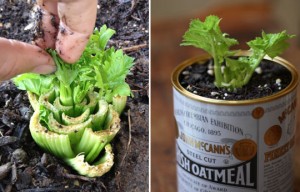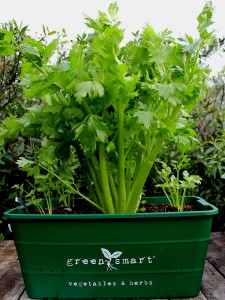Growing Celery in a Planter Box
Growing celery in a planter box is a great challenge which makes it all the more rewarding. The crisp clean taste of eating your own organically grown celery bears no resemblance to the chemically-pumped up supermarket varieties. Here’s some points aimed at experienced gardeners using GreenSmart™ Pots:
- Acknowledge that Celery is difficult to grow without chemical fertilisers.
- Don’t be stingy with fertiliser. Stinginess = Stringiness. Load up the pot with plenty of organic fertiliser before planting.
- Celery was originally a swamp plant so thrives with access to water as provided by a GreenSmart™ Pots.
Conditions for growing celery in a planter box
Plant seedlings in September to December or March-April. Plant when soil conditions in the pot are 12-21 deg C. Celery prefers mild to cool conditions but also does well in warmer climates in late summer and autumn. They survive frosts. As the seeds are very slow to germinate it is better to start with seedlings. Allow for 8 plants per small GreenSmart™ pot or 12 per large GreenSmart™ pot . As celery originated in wetland areas it needs plenty of water and nutrients. Allow for a minimum of 6 hours sun per day but protect from hot sun during hotter months. Blanching prevents bitterness. You can partially blanch by tying twine around the plant to force the stalks together.
Did you know that you can also re-grow celery by cutting off the base from a bunch of store-bought celery?

Regrowing celery
Planting Suggestion:
:Inter-plant 6 celery plants with 6 lettuce plants. The lettuce will be ready to eat in 3-4 weeks. By the time lettuce is finished the celery will be 30 cm high and you can replace the lettuces with another 6 celery plants to give continuity.
Fertiliser
Prepare the pot with plenty of nutrients and rich humus eg compost, animal manure, blood and bone, sheep manure pellets, Yates Dynamic Lifter. Supplement with additional liquid fertilisers during growth period. Be generous with fertiliser to avoid stringy and bitter celery.
Pests and Diseases
The younger plants might be attacked by slugs and snails. Check after dark and apply digital control! If the plants develop distorted leaves or cracked stems it is indicative of boron deficiency so spray with liquid seaweed like Natrakelp.
Avoid splashing water off the soil up onto the plants. This will reduce the risk of fungal infections when growing celery in planter boxes.
Companions
Celery plants like the company of beans, cabbage, onion, spinach, tomatoes, nasturtium.
Harvesting
When growing celery in planter boxes take care when removing outside stalks that you don’t move the whole plant as celery is shallow rooted. Cut the stalk just below the soil line. The inner stalks are more tender than the outer stalks so are better for eating raw. By picking the outer stalks like silverbeet you will be able to continue harvesting over a 2-3 month period.
Celery In the Kitchen
Here are some great celery recipes. Click here to view them now.
Early spring is a good time to clean up your GreenSmart pots in preparation for another season’s growing.
- Tip out the potting mix from the pot. Turn it over for aeration. You should be able to re-use your potting mix 4-5 times.
- Clean out the water sight glass and false floor.
- Ensure that the aeration holes are clear.
- Return the potting mix to the pot with fresh fertiliser
- Plant again.
Happy gardening,
Bill.
